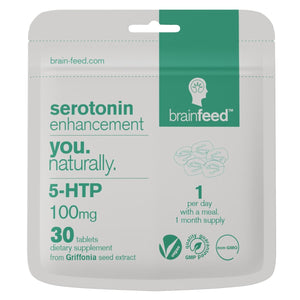How to increase serotonin naturally: Pick the best natural serotonin boosters.
filter
The joy you feel after spending quality time with friends, the good mood after a refreshing nap, and feeling energised after a great workout are all “feel-good” emotions brought to you by your happiness brain chemical, serotonin. Serotonin is vital in experiencing the joys of life. Here are 5 research-backed natural ways to boost serotonin so you can continue feeling happier.
Watch this video & discover how to increase Serotonin naturally:
Eat your way to a serotonin boost.
Your food can alter your mood. Your brain uses a protein building block called tryptophan to make serotonin. Tryptophan is found in protein-rich foods that increase serotonin production. Upon intake, 1-3% of tryptophan enters the brain [1 Trusted Source 2009 - International Journal of Tryptophan Research. Research evaluation L-Tryptophan: Basic Metabolic Functions, Behavioral Research and Therapeutic Indications ] and is converted to 5-HTP, which is then converted to serotonin (5-HT). Some foods rich in tryptophan include.
|
Food (per 100g) |
Tryptophan content (mg) |
|
Frozen dried tofu |
750 |
|
Chia seeds |
720 |
|
Pork |
630 |
|
Mozzarella cheese |
600 |
|
Chicken |
380 |
|
Canned salmon |
350 |
An easier way to make serotonin is to take 5-HTP which is directly converted to serotonin. 5-HTP is available in supplemental form and can boost serotonin levels naturally. It can be considered one of the best supplements for serotonin production. 5-HTP has been researched in mood disorders and yielded promising results. A review of 13 studies found that 5-HTP supplementation led to an improvement in mood and lowered depressive symptoms [2 Trusted Source 2019 - Nutrition Reviews Systematic and meta-analysis Effects of 5-hydroxytryptophan on distinct types of depression: a systematic review and meta-analysis ] . If you are looking for a natural and efficient serotonin booster, consider the world’s first smallest, 98% nutrient-dense tablet providing 100mg 5-HTP per tablet.
Work up a sweat for serotonin gains.
A good workout leaves you sore, yet euphoric. This feeling of happiness is partly due to increased serotonin levels after a workout. Two mechanisms can help understand why exercising makes you happy. Animal studies found that moving muscles allow tryptophan to easily enter the brain, thus making it available for serotonin production [3 Trusted Source 2016 - Frontiers in Psychology Research evaluation Neuromodulation of Aerobic Exercise—A Review ] . Increased movement from exercise also speeds up serotonin transfer between brain cells, contributing to a happier you [4 Trusted Source 2007 - Journal of Psychiatry & Neuroscience Research evaluation How to increase serotonin in the human brain without drugs ] . The great thing about exercise is that even a single session increases serotonin levels, as seen in brain studies. Also, if you exercise regularly, for example swimming for 30 minutes a day for 4 weeks, there is increased serotonin production in your brain, which lasts for a week after you stop [3 Trusted Source 2016 - Frontiers in Psychology Research evaluation Neuromodulation of Aerobic Exercise—A Review ] . If you are new to exercise, you have reason to rejoice; studies have found that all intensities of exercise (low/high) can improve mood. You can start with low-intensity exercises like walking, jogging, cycling etc for 7-75 mins to see benefits in mood [5 Trusted Source 2017 - Brain Plasticity Systematic and meta-analysis The Effects of Acute Exercise on Mood, Cognition, Neurophysiology, and Neurochemical Pathways: A Review ] . You will feel the benefits for up to 24 hrs. In fact, exercise was found to be equally as effective as antidepressants in improving symptoms of mild depression [6 Trusted Source 2022 - British Journal of Sports Medicine Systematic and meta-analysis Comparative effectiveness of exercise, antidepressants and their combination in treating non-severe depression: a systematic review and network meta-analysis of randomised controlled trials ] . The NHS recommends 150 mins of exercise/week for mood improvement [8 Trusted Source 2021 - NHS 3rd-party source Exercise for depression ] .
Enjoy heartfelt laughter for a serotonin uplift.
A funny joke, a silly video or a comic show can induce laughter. Laughter is a positive emotion that can help relieve stress and lighten your mood. Laughter can also increase serotonin levels [10 Trusted Source 2016 - The Tohoku Journal of Experimental Medicine Research evaluation Therapeutic Benefits of Laughter in Mental Health: A Theoretical Review ] . Laughter has been recognized as a form of therapy to relieve depressive symptoms, also recommended by the NHS. Laughter therapy uses humour in the form of games, clown shows and laughter exercises to improve mental wellbeing. A study of those with depression found that indulging in laughter therapy 5 days a week, helped improve mood in 2 weeks [11 Trusted Source 2015 - Journal of Korean Academy of Nursing Human study Effect and Path Analysis of Laughter Therapy on Serotonin, Depression and Quality of Life in Middle-aged Women ] . Their serotonin levels were also higher after this intervention. End a stressful week with an evening of your favourite comedy show and laugh your way to higher serotonin levels.
Indulge in a massage for a serotonin surge.
A nice, relaxing massage can make you feel calm and put you in a zen mood. Serotonin is a calming brain chemical, which is why a massage can raise serotonin levels. Getting regular massages can increase your serotonin levels by up to 30% [7 Trusted Source 2005 - The International Journal of Neuroscience Research evaluation Cortisol decreases and serotonin and dopamine increase following massage therapy ] . Swedish massage is a common gentle massage involving strokes, kneading and circular movements. In a study where participants received a 30 mins session of Swedish massage, three times a week, reported a 26% improvement in mood scores [9 Trusted Source 2016 - Iranian Red Crescent Medical Journal Human study ffects of Swedish Massage on the Improvement of Mood Disorders in Women with Breast Cancer undergoing Radiotherapy ] . It is important to visit an authorised massage therapist for a safe experience.
Light therapy for a stream of serotonin.
Serotonin production is influenced by light that enters your eyes, which explains why you might feel happier in summer compared to winter. Using bright light can help increase serotonin production. Light is used as a form of therapy for those who feel low mood during changing seasons. This is also recommended by the NHS [12 Trusted Source 2021 - NHS 3rd-party source Treatment - Seasonal Affective Disorder (SAD) ] . Read more about this here. A lamp that provides 6,000 lux -10,000 lux (a measure of brightness) can help boost mood by increasing serotonin levels. 61% of participants who adopted 3 weeks of bright light (6000 lux) therapy reported improvement in feelings of happiness [13 Trusted Source 1998 - Archives of General Psychiatry Human study Bright light treatment of winter depression: a placebo-controlled trial ] . With summer approaching, you can use the abundance of sunlight to boost up your serotonin levels as a human study showed that serum serotonin levels were significantly higher after the first UVA (light that penetrates the skin) exposure[14 Trusted Source 2002 - BMC dermatology Human study Impact of UVA exposure on psychological parameters and circulating serotonin and melatonin ] . Additionally, exposure to light has been reported to activate the production of serotonin from 5-htp in yeast extracts, suggesting a direct relationship between sunshine and the production of serotonin[15 Trusted Source 1989 - Photochemistry and Photobiology Research evaluation Near-UV activation of enzymatic conversion of 5-hydroxytryptophan to serotonin ] .
Enhancing your serotonin levels is easily achievable by using a 5-HTP supplement, exercising, having a laugh, getting a massage and soaking up the sunlight.
References
- Richard, D.M., et al. (2009). L-Tryptophan: Basic Metabolic Functions, Behavioral Research and Therapeutic Indications. International Journal of Tryptophan Research. https://www.ncbi.nlm.nih.gov/pmc/articles/PMC2908021/
- Javelle, F. et al. (2019). Effects of 5-hydroxytryptophan on distinct types of depression: a systematic review and meta-analysis. Nutrition Reviews. https://academic.oup.com/nutritionreviews/article-abstract/78/1/77/5555860?redirectedFrom=fulltext
- Heijnen, S. et al. (2016). Neuromodulation of Aerobic Exercise-A Review. Frontiers in psychology. https://www.frontiersin.org/journals/psychology/articles/10.3389/fpsyg.2015.01890/full
- Young S. N. (2007). How to increase serotonin in the human brain without drugs. Journal of psychiatry & neuroscience: JPN, 32(6), 394–399. https://www.researchgate.net/publication/5803644_How_to_increase_serotonin_in_the_human_brain_without_drugs
- Basso, J. C., & Suzuki, W. A. (2017). The Effects of Acute Exercise on Mood, Cognition, Neurophysiology, and Neurochemical Pathways: A Review. Brain plasticity (Amsterdam, Netherlands), 2(2), 127–152 https://content.iospress.com/articles/brain-plasticity/bpl160040
- Recchia, F. et al. (2022). Comparative effectiveness of exercise, antidepressants and their combination in treating non-severe depression: a systematic review and network meta-analysis of randomised controlled trials. British Journal of Sports Medicine. [online] https://bjsm.bmj.com/content/56/23/1375
- Field, T. et al. (2005). Cortisol decreases and serotonin and dopamine increase following massage therapy. The International journal of neuroscience, 115(10), 1397–1413. https://www.tandfonline.com/doi/full/10.1080/00207450590956459
- NHS (2021). Exercise for depression. [online] https://www.nhs.uk/mental-health/self-help/guides-tools-and-activities/exercise-for-depression/
- Darabpour, S. et al. (2016). Effects of Swedish Massage on the Improvement of Mood Disorders in Women with Breast Cancer undergoing Radiotherapy. Iranian Red Crescent medical journal, 18(11), e25461. https://www.ncbi.nlm.nih.gov/pmc/articles/PMC5292140/
- Yim J. (2016). Therapeutic Benefits of Laughter in Mental Health: A Theoretical Review. The Tohoku journal of experimental medicine, 239(3), 243–249. https://www.jstage.jst.go.jp/article/tjem/239/3/239_243/_article
- Cha, M. Y., & Hong, H. S. (2015). Journal of Korean Academy of Nursing, 45(2), 221–230. https://jkan.or.kr/DOIx.php?id=10.4040/jkan.2015.45.2.221
- NHS (2021). Treatment - Seasonal Affective Disorder (SAD). [online] nhs.uk. https://www.nhs.uk/mental-health/conditions/seasonal-affective-disorder-sad/treatment/
- Eastman, C. I. et al. (1998). Bright light treatment of winter depression: a placebo-controlled trial. Archives of general psychiatry, 55(10), 883–889. https://jamanetwork.com/journals/jamapsychiatry/fullarticle/204290
- Gambichler, T., Bader, A., Vojvodic, M., Bechara, F. G., Sauermann, K., Altmeyer, P., & Hoffmann, K. (2002). Impact of UVA exposure on psychological parameters and circulating serotonin and melatonin. BMC Dermatology, 2, 6. https://bmcdermatol.biomedcentral.com/articles/10.1186/1471-5945-2-6
- Fraikin, G. Y., Strakhovskaya, M. G., Ivanova, E. V., & Rubin, A. B. (1989). Near-UV activation of enzymatic conversion of 5-hydroxytryptophan to serotonin. Photochemistry and Photobiology, 49(4), 475–477. https://onlinelibrary.wiley.com/doi/10.1111/j.1751-1097.1989.tb09197.x


 alertness
alertness
 cognition
cognition
 sleep
sleep
 wellbeing
wellbeing










Leave a comment
Open tab